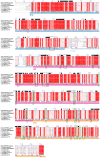Is the C-Terminal Domain an Effective and Selective Target for the Design of Hsp90 Inhibitors against Candida Yeast?
- PMID: 38137982
- PMCID: PMC10745388
- DOI: 10.3390/microorganisms11122837
Is the C-Terminal Domain an Effective and Selective Target for the Design of Hsp90 Inhibitors against Candida Yeast?
Abstract
Improving the armamentarium to treat invasive candidiasis has become necessary to overcome drug resistance and the lack of alternative therapy. In the pathogenic fungus Candida albicans, the 90-kDa Heat-Shock Protein (Hsp90) has been described as a major regulator of virulence and resistance, offering a promising target. Some human Hsp90 inhibitors have shown activity against Candida spp. in vitro, but host toxicity has limited their use as antifungal drugs. The conservation of Hsp90 across all species leads to selectivity issues. To assess the potential of Hsp90 as a druggable antifungal target, the activity of nine structurally unrelated Hsp90 inhibitors with different binding domains was evaluated against a panel of Candida clinical isolates. The Hsp90 sequences from human and yeast species were aligned. Despite the degree of similarity between human and yeast N-terminal domain residues, the in vitro activities measured for the inhibitors interacting with this domain were not reproducible against all Candida species. Moreover, the inhibitors binding to the C-terminal domain (CTD) did not show any antifungal activity, with the exception of one of them. Given the greater sequence divergence in this domain, the identification of selective CTD inhibitors of fungal Hsp90 could be a promising strategy for the development of innovative antifungal drugs.
Keywords: Candida sp.; Hsp90; antifungal targets.
Conflict of interest statement
The authors declare no conflict of interest.
Figures



References
-
- Lortholary O., Desnos-Ollivier M., Sitbon K., Fontanet A., Bretagne S., Dromer F., French Mycosis Study Group Recent Exposure to Caspofungin or Fluconazole Influences the Epidemiology of Candidemia: A Prospective Multicenter Study Involving 2441 Patients. Antimicrob. Agents Chemother. 2011;55:532–538. doi: 10.1128/AAC.01128-10. - DOI - PMC - PubMed
-
- Alexander B.D., Johnson M.D., Pfeiffer C.D., Jiménez-Ortigosa C., Catania J., Booker R., Castanheira M., Messer S.A., Perlin D.S., Pfaller M.A. Increasing Echinocandin Resistance in Candida glabrata: Clinical Failure Correlates With Presence of FKS Mutations and Elevated Minimum Inhibitory Concentrations. Clin. Infect. Dis. Off. Publ. Infect. Dis. Soc. Am. 2013;56:1724–1732. doi: 10.1093/cid/cit136. - DOI - PMC - PubMed
-
- Ostrowsky B., Greenko J., Adams E., Quinn M., O’Brien B., Chaturvedi V., Berkow E., Vallabhaneni S., Forsberg K., Chaturvedi S., et al. Candida Auris Isolates Resistant to Three Classes of Antifungal Medications—New York, 2019. MMWR Morb. Mortal. Wkly. Rep. 2020;69:6–9. doi: 10.15585/mmwr.mm6901a2. - DOI - PMC - PubMed
Grants and funding
LinkOut - more resources
Full Text Sources
Miscellaneous

